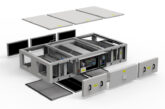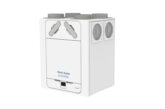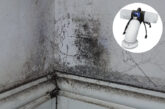
Leading ventilation manufacturer Vent-Axia has welcomed the publication of new Approved Document Part F of the Building Regulations, as a “vital step to improve indoor air quality” as we move toward the Future Homes Standard on the road to Net Zero.
Published on 15th December 2021, Part F (Means of Ventilation) goes hand-in-hand with the new amended Part L (Conservation of Fuel and Power), which is set to help the UK deliver Net Zero with a reduction of almost a third less carbon for new homes. However, as buildings become more air tight to improve efficiency it is essential to consider indoor air quality too to protect the wellbeing of inhabitants. The new Part F therefore sets out “significant changes”, which will drive adoption of low carbon ventilation as an industry standard and improve the quality of the air we breathe in buildings.
A key addition to Part F, which reflects the significance of ventilation in meeting Net Zero, is a new sub section ‘Installing Energy Efficiency Measures’, which relates to existing properties. “When carrying out energy efficiency measures to an existing dwelling, an assessment should determine what, if any, additional ventilation provision is needed, based on the estimated impact of the work.” Vent-Axia welcomes this addition since previously many homes have suffered from condensation, mould and poor indoor air quality following energy efficiency measures, which have increased the airtightness of the building envelope to reduce carbon emissions. This positive move will help protect the health and wellbeing of inhabitants from indoor air pollution and protect buildings from damp, condensation and mould caused by moisture not being able to escape.
For New Build residential homes, ventilation has also increased in Part F to support the safety of residents with an overall move to more advanced ventilation solutions, such as Mechanical Ventilation with Heat Recovery (MVHR) and Continuous Mechanical Extract Ventilation instead of traditional Intermittent Extract Ventilation (now referred to as Natural Ventilation throughout the document). Natural Ventilation is now only suitable for dwellings with a design air permeability higher than 5 m3/(m2·h) meaning many new build dwellings will be out of scope of this technology. With the increased airtightness of buildings, and increased minimum whole dwelling ventilation rates for continuous mechanical extract units, higher performing options are needed. Here housebuilders look to favour continuous mechanical extract units that offer a 125mm diameter spigot model since the larger surface area will allow greater airflow through the fan at a much lower noise level and SFP. This means fewer fans are required to achieve whole house ventilation rates.
“We welcome the new Part F of the Building Regulations. Since Kyoto, the UK has been striving to reduce its carbon emissions. However, unfortunately indoor air quality has taken a back seat. However, over the last 5 years we have all witnessed the real consequences of sealing up homes and insulating them to make them more energy efficient. It has resulted in indoor air pollution. The new Part F has started to redress the balance of ventilation with energy efficiency since the pandemic has clearly shown the importance of good indoor air quality to health and wellbeing”, said Richard Paine Product and Marketing Director at Vent-Axia.
With the pandemic highlighting the importance of good ventilation to mitigate virus transmission, Part F is also introducing improvements to ventilation in new non-residential properties to help prevent the spread of airborne viruses. In fact, it states that in “locations where continuous talking or singing takes place, or there are high levels of physical activity (such as dancing, playing sport or exercising), providing ventilation sufficient to keep CO2 levels below 800ppm is recommended”. There is also a sub section entitled ‘Indoor Air Quality Monitoring’, which states that in new buildings in the occupiable rooms it refers to there “should have a means of monitoring the indoor air quality. This may be achieved using CO2 monitors or other means of measuring indoor air quality.” These actions will help ensure better indoor air quality in non-residential properties.
For non-residential properties, Vent-Axia is well prepared for Part F with a range of CO2 sensors which can be discreetly located on a wall and can intelligently boost ventilation based on the detected CO2 levels. They can also provide a warning indication for occupants if CO2 levels rise above acceptable levels with a useful traffic light system on the front, so occupants can activate purge ventilation when required. Vent-Axia also has a range of ventilation solutions including the Slimpak EC box fan ducted system which continuously supplies fresh air or extracts stale air or both. These fans can be connected to a CO2 sensor for optimal air quality control. Meanwhile, the ACM100-200 and ACM250-315 mixed flow in-line fans provide ceiling mounted cooling in the summer or can recirculate the warm air from the ceiling in the winter to minimise the amount of time space heaters need to be active. Vent-Axia’s Lo-Carbon T-Series fans can provide background or purge ventilation and are easily fitted to an existing window or through a wall.
For New Build residential Vent-Axia has launched the award-winning Multivent MEV family, a new range of mechanical extract ventilation (MEV) and decentralised MEV (dMEV) designed to provide a simple and effective solution to help housebuilders meet the Future Homes Standard. The new Multivent MEV family is the ideal solution, helping housebuilders meet DER requirements through its market-leading energy efficiency and improving IAQ for homeowners. The complementary other half of the Multivent family is Vent-Axia’s Lo-Carbon NBR dMEV, a range of continuous running, constant volume dMEV units. This includes a unique 125mm option which further improves DER by improving efficiency and lowering noise and is ideal to meet the new Part F requirements.
For existing homes, Vent-Axia has a wide range of extractor fans available to help provide effective ventilation and comply with Part F. For example, the Lo-Carbon Svara combines condensation control to avoid mould with improved IAQ for a healthier home environment backed up by easy installation, quiet operation and is controllable via a smartphone. Meanwhile, Vent-Axia’s Silent Fan range boasts seventeen models and a raft of new features, including IPX5-rating (for Zone 1) making installation easier and safer. The range also offers both humidity and variable speed models and is still the quietest bathroom fan available at just 12dB(A). The Vent-Axia PureAir Sense is the UK’s only bathroom fan with Odour Sense technology that increases airflow when the air is poor, helping ensure a comfortable living environment.
Finally, for social housing refurbishments, there are number of options including: Positive Input Ventilation, such as Vent-Axia’s Lo-Carbon PoziDry Pro PIV and Lo-Carbon PoziDry Compact Pro; and continuous extract ventilation such as the Lo-Carbon Revive and Lo-Carbon Response 7, intelligent filter-less fans.
For further information on all products and services offered by Vent-Axia: telephone +44 (0)344 856 0590 or click here











